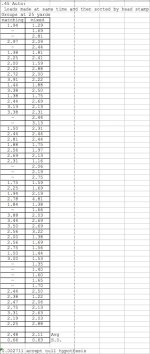A dear friend and member of a local police force gave me, guessing, because I won't count, about 1000 fired .45 ACP cases. I've loaded and fired them without any problems, other than one round out of about 200 seized up in the action and as I extracted it, the bullet pulled out of the case and stayed in the gun. No problem knocking it out with a cleaning rod, and I think it may have seated long.
I just shoot for fun, quick drawing at bowling pins and cardboard targets with balloons representing head and chest shots, and 85% of my shots go where they should at 5 and 10 yards, with 15 yards being less accurate.
But I started to wonder if there was more to inaccuracy than just me. Could there be a difference in the brass?
I have 12 brands that I identified so far; I have not yet gone through the whole 1000 cases. Most common are RP, Federal, Winchester, Speer, PMC and Starline. Less common are Aquila, CBC, Hornady, CCI, PPU and RWS.
I guess I'll end up answering own question because I just loaded 3 of each of the common brands; the cases measured 0.888 to .092 inches after resizing, but individual groups of the same case are closer to each other than the spread. I'm using 4.0 gr of Clays with a Ranier 230gr RN bullets and Remington 2-1/2 large pistol primers. Charges were weighed to 4.0 gr exactly and all the bullets seated to a measured OAL of 1.260." I'll shoot them off a rest at 10 yards to see how they do.
But, in the meantime, I would appreciate any feedback from those who have already gone through this process or have some knowledge that would be of benefit.
I just shoot for fun, quick drawing at bowling pins and cardboard targets with balloons representing head and chest shots, and 85% of my shots go where they should at 5 and 10 yards, with 15 yards being less accurate.
But I started to wonder if there was more to inaccuracy than just me. Could there be a difference in the brass?
I have 12 brands that I identified so far; I have not yet gone through the whole 1000 cases. Most common are RP, Federal, Winchester, Speer, PMC and Starline. Less common are Aquila, CBC, Hornady, CCI, PPU and RWS.
I guess I'll end up answering own question because I just loaded 3 of each of the common brands; the cases measured 0.888 to .092 inches after resizing, but individual groups of the same case are closer to each other than the spread. I'm using 4.0 gr of Clays with a Ranier 230gr RN bullets and Remington 2-1/2 large pistol primers. Charges were weighed to 4.0 gr exactly and all the bullets seated to a measured OAL of 1.260." I'll shoot them off a rest at 10 yards to see how they do.
But, in the meantime, I would appreciate any feedback from those who have already gone through this process or have some knowledge that would be of benefit.

